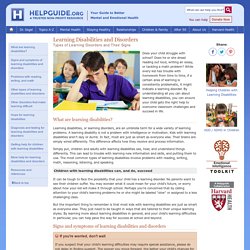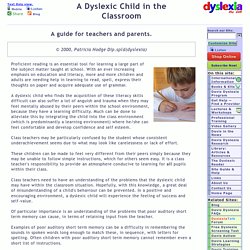

Child Dyslexia: Symptoms, Causes, & Treatments. Why do I need to register or sign in for WebMD to save?

We will provide you with a dropdown of all your saved articles when you are registered and signed in. Dyslexia is a type of learning disability. Before diagnosis, many children with dyslexia are poorly understood. Since dyslexia has nothing to do with a person's intelligence, parents of children with dyslexia are often perplexed when their child does poorly in school or struggles to read a simple book. Is the child lazy? If your child has dyslexia, you have likely asked yourself these questions as you watched your child struggle to keep up with classmates. Child Discipline Tactics Discipline is the process of teaching your child what type of behavior is acceptable and what type is not acceptable. To read more, click here. Is My Child’s Behavior the Sign of a Learning Disability?
Any of this sound familiar?

Your child’s teacher tells you that your son is having trouble sitting still in class…Every day, homework turns into a teary-eyed, hair-pulling, paper-tearing tug o’ war…Your teen is caught painting graffiti on the bathroom wall…You may be baffled by behaviors like these. And, you may wonder whether they could be linked to a learning disability (LD). What follows is a brief overview of some behavioral red flags of learning disabilities. Remember: even when LD is linked to puzzling behaviors, it’s likely other factors contribute as well. Typical Behaviors in Children With LD Tobey Shaw, MA, is principal of the Frostig School, a K–12 school in Pasadena, California, for children with learning disabilities and related learning problems.
Impulsiveness, inattention, or distractibility is also common. Weaknesses in social skills also come with the territory, she says. “Our greatest human psychological need is to ‘belong,’ to have a soft place to fall,” says McIntyre. Guide to Preventing Bullying in the Classroom. Chances are one of your students is being bullied.

And if you’re like most teachers, you’re either unaware of it or you don’t know how to stop it. This is why bullying has become epidemic. The teacher is the only one in position to put a stop to it, and he or she is ill-equipped to do so. This isn’t another article about teaching manners or preaching respect. It’s not about group counseling or community circles. This is about putting an end to bullying. It’s about stepping in and saying, “I’m your teacher, and you will not be bullied. If you want to be that kind of teacher, if you want to end bullying in your classroom forever, if you want to take a stand for those who can’t always stand for themselves, then keep reading. How To Stop Bullying This website can help any teacher get control of, and then thrive in, any classroom. This article is no different. However, it does take a certain amount of work. Let’s get started. Learning Disabilities and Disorders.
What are learning disabilities?

Learning disabilities, or learning disorders, are an umbrella term for a wide variety of learning problems. A learning disability is not a problem with intelligence or motivation. Kids with learning disabilities aren’t lazy or dumb. In fact, most are just as smart as everyone else. Their brains are simply wired differently. Simply put, children and adults with learning disabilities see, hear, and understand things differently. Helping dyslexic children within the classroom. © 2000, Patricia Hodge Dip.spld(dyslexia) Proficient reading is an essential tool for learning a large part of the subject matter taught at school.

With an ever increasing emphasis on education and literacy, more and more children and adults are needing help in learning to read, spell, express their thoughts on paper and acquire adequate use of grammar. A dyslexic child who finds the acquisition of these literacy skills difficult can also suffer a lot of anguish and trauma when they may feel mentally abused by their peers within the school environment, because they have a learning difficulty.
Much can be done to alleviate this by integrating the child into the class environment (which is predominantly a learning environment) where he/she can feel comfortable and develop confidence and self esteem. Class teachers may be particularly confused by the student whose consistent underachievement seems due to what may look like carelessness or lack of effort. In the class: Reading: Spelling: Maths: